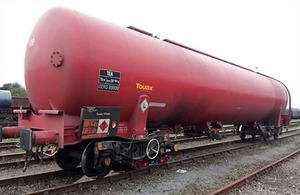Extensive track damage between Ferryside and Llangennech
Investigation into a train causing multiple broken rails and other track damage between Ferryside and Llangennech, Carmarthenshire, 30 October 2017.

The wagon involved, following the incident (image courtesy of DB Cargo)
Between about 06:50 hrs and 08:14 hrs on Monday 30 October 2017, train reporting number 6B13, the 05:00 hrs DB Cargo service from Robeston (Milford Haven) to Westerleigh, caused extensive damage to the track that it travelled over on the part of its journey between Ferryside and Llangennech. The train stopped on the approach to Llangyfelach tunnel, about 70 miles after leaving Robeston, when the driver was told of a possible problem. Subsequent examination by Network Rail found at least nine broken rails, and damage to level crossings and signalling equipment.
The train consisted of a locomotive and 29 loaded tank wagons. Examination of the leading wagon found that the brake rigging on the leading bogie had disintegrated, and that the trailing pair of wheels on that bogie had suffered significant damage (wheel flats). Some of the components of the braking system were hanging down and dragging along the track, and others were missing altogether.
The leading wagon was loaded with 76 tonnes of diesel fuel. The following 28 wagons, also loaded with petroleum products, passed over each rail break without derailing.
The RAIB’s preliminary examination has concluded that the brakes of all the wagons in the train were almost certainly properly released when the train left Robeston. It appears at present that one set of wheels ceased to rotate at some point during the journey, leading to the development of the wheel flats, and began to turn again in the Ferryside area. The impacts from the rotating, damaged, wheels gave rise to the broken rails, and may also have caused the disintegration of the brake rigging.
Our investigation will try to determine the sequence of events and find out why the wheels behaved in this way, and why the braking components failed. It will also examine how the developing incident was handled by the Network Rail operating staff along the route, and consider any underlying management factors.
Our investigation is independent of any investigation by the railway industry, or by the industry’s regulator, the Office of Rail and Road.
We will publish our findings, including any recommendations to improve safety, at the conclusion of our investigation. This report will be available on our website.
You can subscribe to automated emails notifying you when we publish our reports.